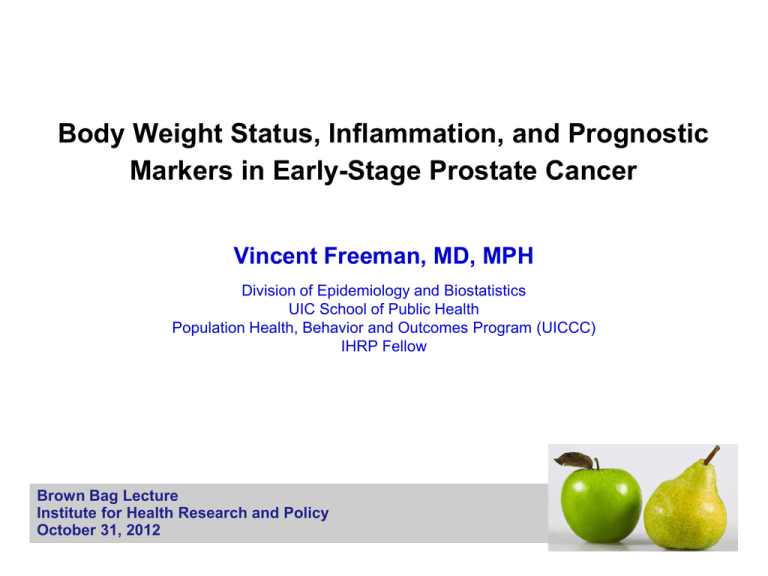Body Weight Status, Inflammation, and Prognostic Markers in Early-Stage Prostate Cancer
advertisement

Body Weight Status, Inflammation, and Prognostic Markers in Early-Stage Prostate Cancer Vincent Freeman, MD, MPH Division of Epidemiology and Biostatistics UIC School of Public Health Population Health, Behavior and Outcomes Program (UICCC) IHRP Fellow Brown Bag Lecture Institute for Health Research and Policy October 31, 2012 Outline Relative risk of cancer mortality in obese men Pathophysiologic basis for excess risk The case for inflammation/immunity in prostate cancer Preliminary results from the “Adiposity and Prostate Cancer” Study Relative risk of cancer mortality in obese men Calle EE et al., NEJM, 2003 Obesity and cancer: possible connections Inflammation: cytokines Adipokines: leptin and adiponectin Growth factors: IGF-1 Energy balance pathways Adipose tissue inflammation in obesity Healthy diet and physical activity Positive energy balance and physical inactivity Leptin & Inflammatory cells in fat tissue and throughout the body Gleeson et al., Nature Rev Immunol, 2011 Leptin and Immunity La Cava et al., Nature Rev Immunol, 2004 Adiponectin Tumor necrosis factors α (TNFα) Interleukin-6 Inflammation as the seventh hallmark of cancer 2 1 3 7 4 6 5 Colotta F et al. Carcinogenesis 2009;30:1073-1081 The Case for Inflammation / Immunity in Prostate Cancer Distribution of inflammation, Proliferative Inflammatory Atrophy (PIA), HGPIN, and Prostate Ca in the Human Prostate Radical prostatectomy specimen PIA lesion • Inflammatory infiltrate in and around foci of atrophy • Increased proliferative index • Can transition directly to HGPIN or prostate cancer De Nunzio, Eur Urol 2011 NIH/AARP Diet and Health Study: Cubic spline regression for prostate cancer incidence and mortality according to BMI Relative Risk Total Incident Relative Risk Obese Localized Mortality Relative Risk Relative Risk Extraprostatic BMI BMI Ref .= 23.5 kg/m2 Wright et al. Cancer, 2007 Obesity / Excessive Adiposity and Prostate Cancer A threat to prostate cancer prevention and control Excess body fat and the pathophysiogic consequences thereof are potential targets for chemoprevention Adiposity and Outcomes of Clinically Localized Prostate Cancer NIH/NCI 1R01CA129140 Objectives Measure the association of adiposity with risk factors for prostate cancer-specific morbidity and mortality based on more thorough assessment of body size and composition Clarify the mediating physiologic mechanisms Specific Aims Conduct a prospective cohort study to measure the association of body fatness with prognostic tumor parameters and biochemical (PSA) failure Measure a) fatty acids, b) IGF axis activity, c) modulators of Inflammation, d) and sex steroid hormones in prostate tissue and peri-prostatic fat to analyze which factors mediate the associations Explore the effect of post-treatment changes in body weight status on 2-year risk of PSA failure Study Design – Recruitment and Data Collection 350 men awaiting RP • • • • UIC Loyola Hines VAH Stroger/Cook County Visit 1 (pre-op) • • • • • Visit 2 (1 year post-op) Repeat anthros, DXA blood, and surveys • Consent to f/u for 10 years Anthropometrics DXA Blood Lifestyle and Health Surveys (FFQ, physical activity, social, and health) Surgery Outcome Ascertainment • • • Central Path Review at UIC Serial PSAs per usual care Medical record review • • Fresh non-malignant prostate Regional prostatic adipose tissue Exposures & Outcomes for Aim 1 Exposures Outcomes – Aim 1 Generalized adiposity • BMI • Total body fat • Biochemical failure < 2 years (PSA > 0.1 ng/ml within 2 yrs) Central Adiposity • Waist Secondary Circumference • Receipt of additional (RT, ADT, other) • Waist/Hip ratio • Clinical Progression • Trunk fat mass • Prostate cancer-specific mortality Primary • Visceral adipose tissue mass Other • Body weight Δ Other since age 25 & 40 years • Tumor-positive surgical margins • D’Amico 5-yr PSA recurrence risk score • Kattan 2, 5, 7, and 10-yr PSA recurrence risk probabilities Dual Energy Absorptiometry (DXA) Progress Report • 223 men enrolled as of 10/30/12 • % of eligible subjects consented = 59.2% • Tissue-based analyses completed in 72-90 subjects (32-40%) depending on analyte Studies in Prostate and Adipose Tissue (Aim 2) System/Pathway Fatty Acids Investigator Meydani (Tufts) Analyte Oleic/Stearic acid, %Essential FAs IGF-Axis Activity Swanson (UIC) IGF-1 (Total, Free) IGFBP 1-3 IGF-1R mRNA Phosphorylated IGF-1R mRNA Inflammation / Immunity Fantuzzi (UIC) White Adipose Tissue (WAT)-Derived Peptide Hormones Eicosanoids Sex Steroids Leptin & Adiponectin Meydani (Tufts) Meydani (Tufts) IL6 TNF-α MCP-1 PGE2 LTB4 Van Breemen (UIC) Testosterone (Total and Free) Prins (UIC) Dihydrotestosterone Estradiol 3-α (17-β) Androstanediol 3-β Androstanediol Preliminary Results - Outline Cross-sectional analysis of body weight status prostatic levels of adipocytokines • Leptin • Adiponectin • IL-6 • TNF-a Body weight status and prostate cancer outcomes Prostatic adipocytokines and prognostic markers Lifestyle/Behavioral Interventions What are we trying to accomplish? • • Prevent spread of the tumor outside of the gland? Prevent (or slow) progression of nonorgan confined disease? “Excess body fat and the molecular biologic consequences thereof are potential targets for chemoprevention.” Summary Obesity/excessive adiposity increases the risk of cancerrelated morbidity and mortality. Our preliminary results convincingly establish that obesity/excessively adiposity increases the concentration of pro-inflammatory factors in the prostate gland of men with early prostate cancer. Of the pro-inflammatory factors studied thus, prostatic levels TNFa appears to associate with some risk factors for prostate cancer recurrence after surgery (“treatment failure”). Summary Additional analyses in the rest of the cohort are pending. However, if these early results are replicated, we will have established a mechanistic link between obesity and risk of prostate cancer recurrence after “curative” therapy. Prostate cancer recurrence in our cohort means that the cancer probably had already spread outside of the gland by the time of surgery. Therefore, our ability to intervene early enough to prevent this may be limited. However, an understanding of the molecular biology of the obesity-prostate cancer mortality association would identify drug targets that could complement lifestyle and behavioral interventions to prevent further cancer progression. Acknowledgements UROLOGY NUTRITION/HEALTH PROMOTION University of Illinois at Chicago (UIC) Leslie Deane, MD Stewart B. Lipson, MD Gail Prins, PhD UIC Giamila Fantuzzi, PhD* Maria Pini, MS / Karla Castellanos, MS Carol Braunschweig, PhD, MPH Marian Fitzgibbon, PhD Sandra Gomez, MS Loyola University Medical Center Robert C. Flanigan, MD (Site PI) Marcus Quek, MD Hines VAH Jeffrey Branch, MD (Site PI) Nicholas Friedman, MD Stroger Hospital Courtney Hollowell, MD (Site PI) Patricia Vidal, MD Marin Sekosan Tufts University Mohsen Meydani, PhD, DVM *A special “thank you” to Dr. Giamila Fantuzzi for providing several of the figures adapted for this presentation Acknowledgements PATHOLOGY UIC Andre Balla, MD, PhD Vicky Macias, MD Loyola University Medical Center Guliz Barkan, MD SCHOOL OF PHARMACY University of Illinois at Chicago (UIC) Steven Swanson, PhD Richard van Breemen, PhD PROJECT MANAGER Daisy Cintron, MA Site Coordinators Linda Millbrandt (Loyola) Anne Garabedian (Hines VA) Jasmine Cleofe (Stroger) Statistical Support Young Ku-Choi, PhD (deceased) Li Liu, PhD Firas Dabbous, Graduate Research Assistant CTSA at UIC Phlebotomy support UIC Grants Manager Paul Racinski, MA Thank you.




